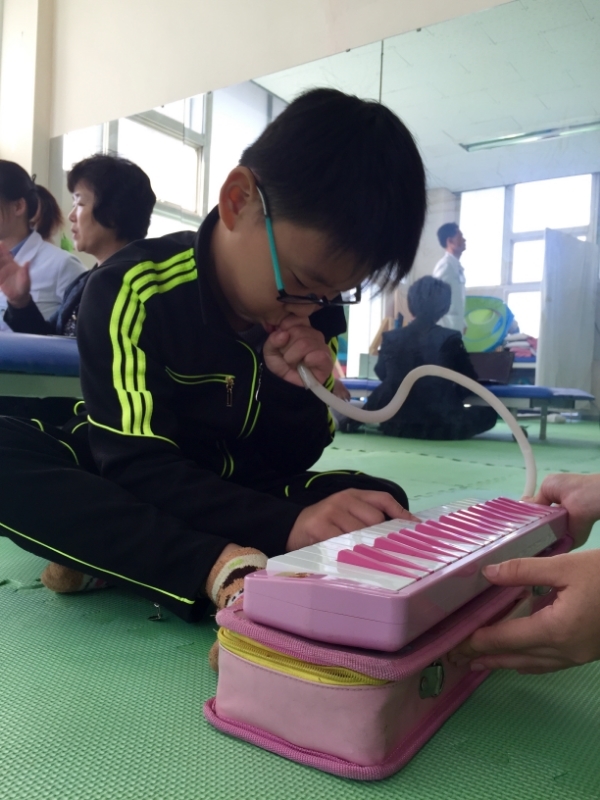Today, March 25th, is National Cerebral Palsy Awareness Day— and as we made it our prayer focus of the month, we want to celebrate this day by sharing an interview with our field director, Joy Yoon. Joy is currently residing in Pyongyang with her husband, Dr. Stephen Yoon, and their three children: Sarah, Caleb and Anna. Stephen and Joy are working to address cerebral palsy in the DPRK by training doctors and treating children at the Pyongyang Medical School Children's Ward. We hope that our hospital (Pyongyang Spine Rehabilitation Center) will be completed by the end of 2016 to expand the treatment to hundreds of other children living with CP in the country.
We want to highlight Joy's interview today because she is participating in Pyongyang's 10k race next month (April 10, 2016) to raise awareness and funds for CP children in North Korea. We set up a race campaign called, "Run with Joy" for supporters to join her. As she takes off on this big race, we hope you are inspired by her heart for the children!
Check out her interview below:
What is your role for the PYSRC program?
J: As my husband, Stephen, treats children with cerebral palsy through physical therapy, I am involved in developing a special education program for the children in the hospital. I also participate in occupational therapy for the patients, primarily helping them through educational and speech therapy. Together our dream is to provide new hope to children and their families with cerebral palsy.
What are the biggest challenges of working with CP children?
J: The biggest challenges in working with children who have cerebral palsy are that each child is unique and requires an individualized program of both education and therapy. Sometimes it takes several months to find the root causes for intervention. In addition, since we are working in a developing country, there are few resources and expertise to support us. Currently, there is no special education in the entire nation besides a school for the blind and deaf. Therefore, we are having to create our own curriculum while gathering the appropriate educational supplies and therapy equipment to serve each child's individual needs.
What is the most memorable experience you have had living in DPRK?
J: The most memorable experience I have had working in the DPRK was witnessing our first CP patient walk out of the hospital. This ten year-old girl that came to us was unable to sit-up or walk. She was quadriplegic and had to be strapped to a chair just to listen in on class lessons. But after about 11 months of intense therapy, she was able to walk out of the hospital without any assistance. This young lady is now attending regular school and hopes to become a doctor so that she can treat other children like herself someday.
What are some common misconceptions people may have about CP?
J: Many people assume that the physical capabilities of children with CP match their intellectual abilities. However, the truth is that about 70% of CP children have normal intelligence— some are extremely intelligent. With a little extra effort put into their education and therapy, they can become significant contributors to society. Every child has a gift to share, and CP children can be part of this blessing to society.
Is there one particular success story that has impacted you in a special way?
J: One ongoing success story is about a boy who has just turned ten years-old. He came to us when he was eight, unable to stand-up or walk. Now, he is not only standing but also walking and jumping. I have been educating this boy for the past two years, and I am amazed how talented he is. He especially has a sharp ear and can easily learn foreign languages and music. His ear has perfect pitch. If you sing him a song, he can sing it back to you with the exact notes you sang. Unfortunately, because he is visually impaired, he is behind in his education. This young man has never attended school. If technology were available, he could learn through books-on-tape or through print enlarged onto a computer screen, but right now there are no resources for that. One of the reasons I am running this 10 km race is to raise funds to buy educational technology for children like this boy. If he could be assisted by a computer tablet to read in large print and have books read out-loud to him, his educational potential would expound.
Where do you see PYSRC in the next five years?
J: In five years’ time, it is our dream that the PYSRC will be treating patients and training doctors in Pediatric Developmental Disabilities and Pediatric Rehabilitation from all over the nation. Through this specialty training program, doctors will be commissioned to all ten Provincial Pediatric Hospitals to treat children with cerebral palsy throughout the country. In addition, I envision a special education program ongoing in each Provincial Pediatric Hospital to educate children with developmental disabilities. Educational therapy, speech therapy, sensory therapy, occupational therapy and physical therapy will all be inclusive in these Pediatric Rehabilitation Departments.



